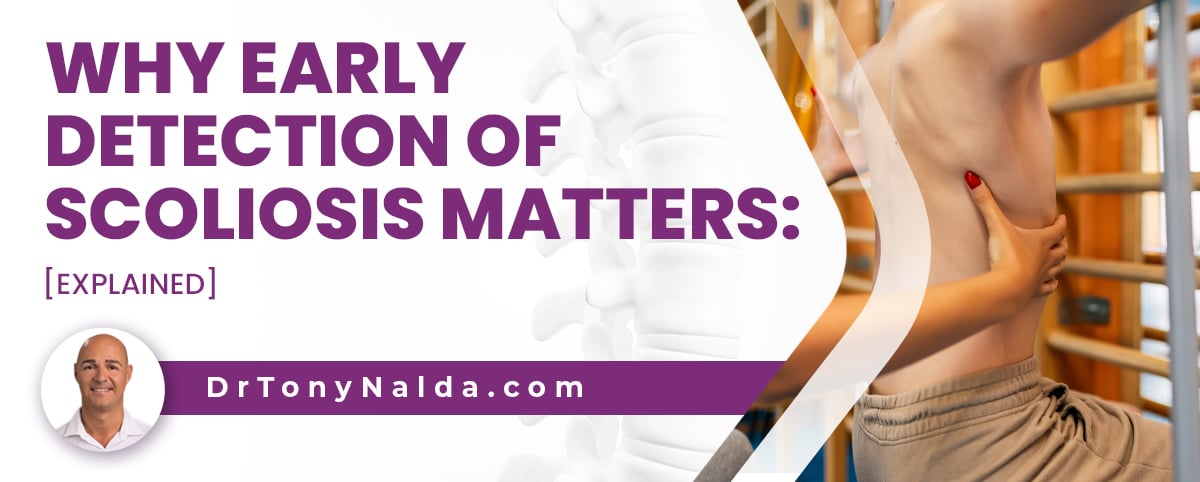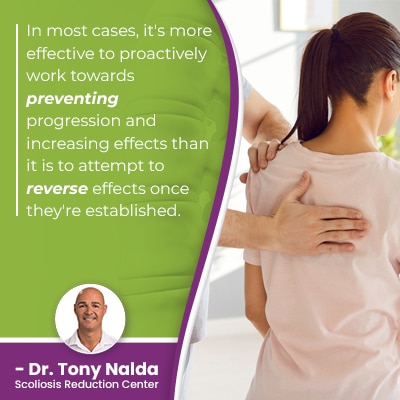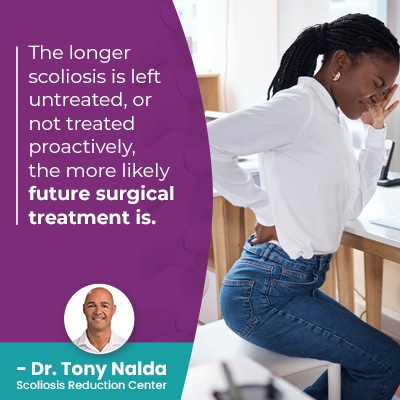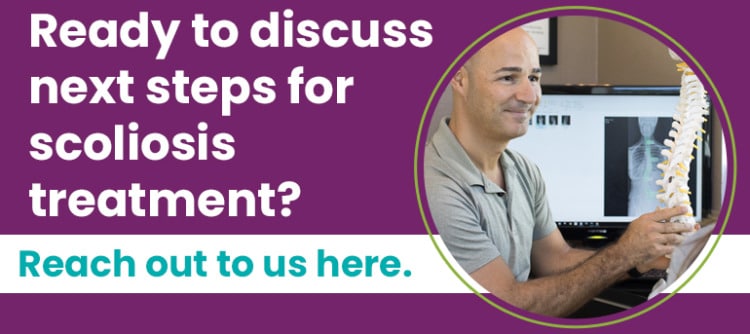Why Early Detection of Scoliosis Matters: [Explained]

Scoliosis can be highly treatable, especially when treatment is started early in a condition's progressive line. The more a condition progresses, the more severe it becomes, and the more complex it is to treat. Mild cases are easier to correct because the spine is more flexible and significant progression hasn't yet occurred.
Early detection doesn't guarantee treatment success, but there is a direct link between the two. Early detection means diagnosing conditions while they are still mild, when they are most likely to be responsive to treatment: important because scoliosis is progressive.
Let's start with how scoliosis is diagnosed and what it means to be diagnosed with scoliosis.
Table of Contents
Diagnosing Scoliosis
There are a number of spinal conditions that cause a loss of healthy spinal curves, but scoliosis has some unique characteristics that set it apart.
In order to be diagnosed as scoliosis, the spine has to bend unnaturally to the side, but it also has to rotate, making scoliosis a complex 3-dimensional condition.
Diagnosing scoliosis isn't always easy, particularly when mild, and especially in children for whom the condition isn't commonly painful; compression is the main cause of condition-related pain, and scoliosis becomes a compressive condition once skeletal maturity is reached.
The constant lengthening motion of a growing spine counteracts compression, and this can make early detection of childhood scoliosis a challenge.
In addition to bending and twisting unnaturally, the size of the unhealthy spinal curvature has to be of a minimum size: Cobb angle measurement of at least 10 degrees.
The higher a patient's Cobb angle, the more severe the condition, and scoliosis can range widely in severity:
- Mild scoliosis is diagnosed with Cobb angles of between 10 and 25 degrees
- Moderate scoliosis involves measurements of between 25 and 40 degrees
- Severe scoliosis is diagnosed at 40+ degrees
- Very-severe scoliosis is diagnosed at 80+ degrees
There are also different types of scoliosis that can be diagnosed, but the most common type to affect all ages is idiopathic scoliosis.
Idiopathic means cause unknown, and while we don't know what causes the initial onset of idiopathic scoliosis, we know how important early detection is, and we know how to respond to a diagnosis with treatment.
The Benefits of Early Detection
 Early detection of scoliosis can be difficult to achieve; its signs can be subtle, and when mild, it's not associated with functional deficits.
Early detection of scoliosis can be difficult to achieve; its signs can be subtle, and when mild, it's not associated with functional deficits.
Most patients are diagnosed with moderate scoliosis because it's when conditions have progressed from mild to moderate that their signs become more noticeable.
We don't understand the cause of idiopathic scoliosis, but we know it's growth that makes it progress, which is why childhood scoliosis should always be taken seriously and early detection is particularly important when addressing scoliosis in children.
Adults still progress, but not at the same rate as children can as growth spurts trigger progression.
The most common type of scoliosis overall is adolescent idiopathic scoliosis diagnosed between the ages of 10 and reaching skeletal maturity, and this age group is the most at risk for rapid-phase progression due to the rapid and unpredictable growth spurts of puberty.
The benefits of early detection are that if diagnosed early, treatment can be started early, and scoliosis is more responsive the milder it is when treatment is started; with progressive conditions like scoliosis, when treatment starts is an important factor.
Increasing Spinal Rigidity
Scoliosis progressing means the size of the unnatural spinal curvature is increasing, as are the condition's uneven forces being exposed to the body.
As scoliosis progresses, the condition's effects are becoming more noticeable and the condition is becoming more complex to treat.
In most cases, it's more effective to proactively work towards preventing progression and increasing effects than it is to attempt to reverse effects once they're established.
In children, the main effects of scoliosis involve postural changes such as uneven shoulders, uneven hips, and the development of a rib cage arch, and in adults, the main symptom of scoliosis is pain.
The spine becomes more rigid alongside progression, making it less responsive to treatment; in fact, in some cases where significant progression has already occurred, some preparatory work has to be done prior to starting the regular course of treatment to establish a baseline level of spinal flexibility.
Starting treatments while the spine is still flexible can be highly beneficial.
Preventing Progression
The nature of scoliosis is to get worse over time, so diagnosing scoliosis early means treatment can be started early, but the benefits of early intervention are only available to those who commit to a proactive conservative treatment approach.
Not all treatment approaches include a proactive response.
When treatment is started immediately following a diagnosis, it can work towards preventing further progression by counteracting its progressive nature.
The goal of childhood scoliosis treatment is to counteract the condition's progressive nature despite the constant trigger of growth.
Preventing progression involves achieving a curvature reduction and holding the reduction despite growth occurring; an important part of this is treatment integration and customization so treatments can be apportioned accordingly and adjusted based on how the spine is responding to growth and/or treatment.
Preventing progression also means preventing increasing condition effects.
Preventing Increasing Condition Effects
Early detection can be difficult because the signs of mild scoliosis are mild, but if left untreated, mild scoliosis can easily become moderate, severe, or very severe scoliosis.
Those who are aware of the condition's early signs are more likely to recognize them, so awareness is important.
As scoliosis progresses and the condition becomes more severe, its effects become more severe, including postural and movement changes in children, and pain in adults.
Movement changes include disruptions to a person's gait, balance, and coordination.
Postural changes are caused by the condition's uneven forces disrupting the body's overall symmetry, and as these changes become more pronounced, they are also becoming more established and difficult to reverse.
So if proactive treatment successfully prevents further progression, it's also preventing further postural and movement changes.
The milder postural and movement changes are when treatment is started, the easier they are to correct.
Avoiding the Need for Spinal Fusion Surgery
 Another goal of a proactive non-surgical treatment approach is to help patients avoid the hardships associated not only with increasing condition effects, but also the result of that: the need for more invasive forms of treatment.
Another goal of a proactive non-surgical treatment approach is to help patients avoid the hardships associated not only with increasing condition effects, but also the result of that: the need for more invasive forms of treatment.
The longer scoliosis is left untreated, or not treated proactively, the more likely future surgical treatment is.
When/if a case of scoliosis progresses into the severe classification, the potential efficacy of non-surgical treatment decreases, and spinal fusion comes with its share of significant potential risks, side effects, and complications.
In addition, even when successful at straightening the bent spine, the way it does so is contrary to the spine's natural movement-based design so can negatively shape the spine's future health, strength, and function.
Once a spine is fused, it's fused for life; the only recourse if the fusion is unsuccessful, or if hardware attached to the spine malfunctions, is more surgery, and the risks increase with each subsequent procedure.
Scoliosis surgery is invasive, and a goal of my approach here at the Scoliosis Reduction Center® is to help patients avoid the need for surgical intervention by addressing scoliosis proactively.
Conclusion
So why is early detection of scoliosis important? Because it increases the likelihood of treatment success.
It's also important because it can mean sparing patients the hardships associated with progression, increasing condition severity, and the need for invasive treatment.
As scoliosis ranges widely from mild to moderate, severe, and very severe, the goal of treatment is to stop a condition from getting worse: counteracting its progressive nature.
Early detection means a condition has been diagnosed early in its progressive line, and for those committing to a proactive treatment approach, the benefit of early intervention is there.
Mild curves are smaller, more flexible, and easier to correct, so starting treatment immediately following a diagnosis means conditions are at their mildest and are the most likely to respond well.
Treating scoliosis with surgery involves fusing the spine's most-tilted vertebrae into one solid bone and attaching metal rods to the spine with screws to hold it in place, and non-surgical interventions includes chiropractic care, physical therapy, scoliosis exercises, corrective bracing, and rehabilitation.
An unnatural spinal curvature needs to be addressed, but not all cases of scoliosis require spinal surgery, especially when early detection and intervention is achieved.
A child's spine is vulnerable to progression because of growth, and scoliosis curves are more responsive the milder they are, and the sooner treatment is started.
So while it's never too late to start treatment, the best time to start addressing scoliosis with treatment is always now.
Dr. Tony Nalda
DOCTOR OF CHIROPRACTIC
After receiving an undergraduate degree in psychology and his Doctorate of Chiropractic from Life University, Dr. Nalda settled in Celebration, Florida and proceeded to build one of Central Florida’s most successful chiropractic clinics.
His experience with patients suffering from scoliosis, and the confusion and frustration they faced, led him to seek a specialty in scoliosis care. In 2006 he completed his Intensive Care Certification from CLEAR Institute, a leading scoliosis educational and certification center.
About Dr. Tony Nalda
 Ready to explore scoliosis treatment? Contact Us Now
Ready to explore scoliosis treatment? Contact Us Now





